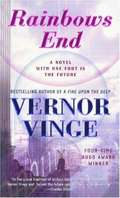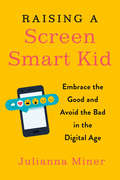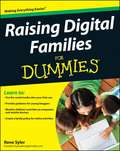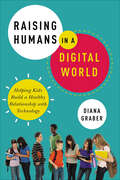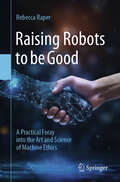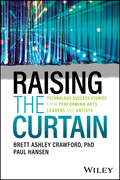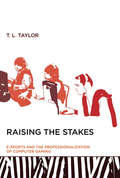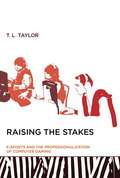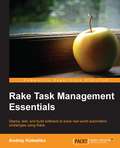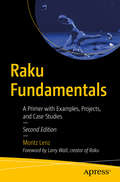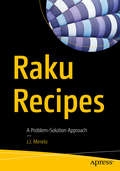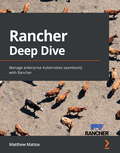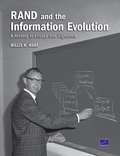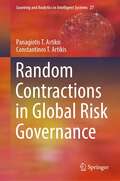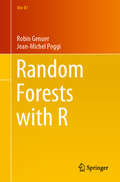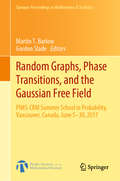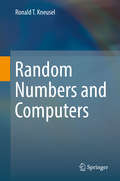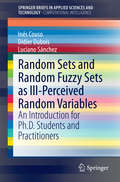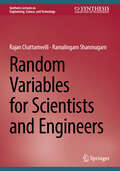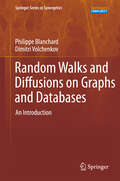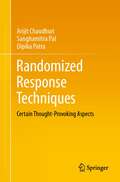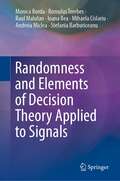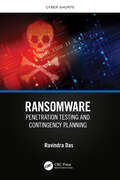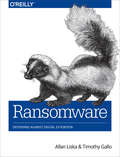- Table View
- List View
Rainbows End
by Vernor VingeFour time Hugo Award winner Vernor Vinge has taken readers to the depths of space and into the far future in his bestselling novels A Fire Upon the Deep and A Deepness in the Sky. Now, he has written a science-fiction thriller set in a place and time as exciting and strange as any far-future world: San Diego, California, 2025.<P><P> Robert Gu is a recovering Alzheimer's patient. The world that he remembers was much as we know it today. Now, as he regains his faculties through a cure developed during the years of his near-fatal decline, he discovers that the world has changed and so has his place in it. He was a world-renowned poet. Now he is seventy-five years old, though by a medical miracle he looks much younger, and he's starting over, for the first time unsure of his poetic gifts. Living with his son's family, he has no choice but to learn how to cope with a new information age in which the virtual and the real are a seamless continuum, layers of reality built on digital views seen by a single person or millions, depending on your choice. But the consensus reality of the digital world is available only if, like his thirteen-year-old granddaughter Miri, you know how to wear your wireless access -- through nodes designed into smart clothes -- and to see the digital context -- through smart contact lenses.<P> With knowledge comes risk. When Robert begins to re-train at Fairmont High, learning with other older people what is second nature to Miri and other teens at school, he unwittingly becomes part of a wide-ranging conspiracy to use technology as a tool for world domination.<P> In a world where every computer chip has Homeland Security built-in, this conspiracy is something that baffles even the most sophisticated security analysts, including Robert's son and daughter-in law, two top people in the U.S. military. And even Miri, in her attempts to protect her grandfather, may be entangled in the plot.<P> As Robert becomes more deeply involved in conspiracy, he is shocked to learn of a radical change planned for the UCSD Geisel Library; all the books there, and worldwide, would cease to physically exist. He and his fellow re-trainees feel compelled to join protests against the change. With forces around the world converging on San Diego, both the conspiracy and the protest climax in a spectacular moment as unique and satisfying as it is unexpected. This is science fiction at its very best, by a master storyteller at his peak.<P> Hugo Award winner.
Raising a Screen-Smart Kid: Embrace the Good and Avoid the Bad in the Digital Age
by Julianna MinerFor parents who didn't grow up with smartphones but can't let go of them now, expert advice on raising kids in our constantly connected worldMost kids get their first smartphone at the same time that they're experiencing major developmental changes. Making mistakes has always been a part of growing up, but how do parents help their kids navigate childhood and adolescence at a time when social media has the potential to magnify the consequences of those mistakes? Rather than spend all their time worrying about the worst-case scenario, readers get a bigger-picture understanding of their kids' digital landscape. Drawing on research and interviews with educators, psychologists, and kids themselves, Raising a Screen-Smart Kid offers practical advice on how parents can help their kids avoid the pitfalls and reap the benefits of the digital age by: * using social media to enhance connection with friends and family, instead of following strangers and celebrities, which is a predictor of loneliness and depression * finding online support and community for conditions such as depression and eating disorders, while avoiding potential triggers such as #Thinspiration Pinterest boards * learning and developing life skills through technology--for example, by problem-solving in online games--while avoiding inappropriate contentWritten by a public health expert and the creator of the popular blog Rants from Mommyland, this book shows parents how to help their kids navigate friendships, bullying, dating, self-esteem, and more online.
Raising Digital Families For Dummies
by Amy Lupold BairGet on the same online playing field as your children with this helpful resourceThe youngest generation will never know life without iPhones, iPods, and Facebook, and while their parents have witnessed the evolution of technology, it is still a challenge to keep up with the pace at which things change. This easy-to-understand guide helps you get up to speed on everything you need to know NOW in order to keep up with your children's online and gadget activity. The book offers invaluable guidance for managing mobile devices, social media, and the Internet before it manages you! Also featured are tips and advice for establishing family rules for technology use and how to best handle situations when rules are broken. Covers monitoring software for computers and mobile devicesOffers advice for handling cyberbullies and introduces safe social networks for childrenAddresses how to guide children who want to blog or podcastProvides information on helpful sites that you may want to explore for more issues on various issues that relate to the future of technologyWhether you want to control mobile device usage or monitor social network activity, Raising Digital Families For Dummies will guide you through acquiring a better handle on this important part of your children's lives.
Raising Humans in a Digital World: Helping Kids Build a Healthy Relationship with Technology
by Diana GraberThe Internet can be a scary, dangerous place especially for children. This book shows parents how to help digital kids navigate this environment.Sexting, cyberbullying, revenge porn, online predators…all of these potential threats can tempt parents to snatch the smartphone or tablet out of their children&’s hands. While avoidance might eliminate the dangers, that approach also means your child misses out on technology&’s many benefits and opportunities.In Raising Humans in a Digital World, digital literacy educator Diana Graber shows how children must learn to handle the digital space through:developing social-emotional skillsbalancing virtual and real lifebuilding safe and healthy relationshipsavoiding cyberbullies and online predatorsprotecting personal informationidentifying and avoiding fake news and questionable contentbecoming positive role models and leadersRaising Humans in a Digital World is packed with at-home discussion topics and enjoyable activities that any busy family can slip into their daily routine.Full of practical tips grounded in academic research and hands-on experience, today&’s parents finally have what they&’ve been waiting for—a guide to raising digital kids who will become the positive and successful leaders our world desperately needs.
Raising Robots to be Good: A Practical Foray into the Art and Science of Machine Ethics
by Rebecca RaperIn 1941 Isaac Asimov famously introduced us to the idea of Robots with the ability to tell between right and wrong. However, as his stories go on to show, the ‘Laws of Robotics’ weren’t quite able to govern robots in a way that we would deem acceptable for humanity. In recent years, scientists have worked to try to understand how we might create robots with this capability – robots with morals – and as Robots and Artificial Intelligence Systems become more integrated into society and our lives, it seems that achieving this aim is as pertinent as ever. This book introduces this pursuit, known as Machine Ethics, and aims to outline some of the art and science behind the field – including the philosophy, psychology and computer science that underpins much of the research into this area. After the necessary background, and an exploration of the problem, a new theory is proposed inspired how we might envisage moral agency developing in a child. The proposal is that we need to cultivate moral development in a robot, in pretty much the same way we might parent a child: Raising Robots to be Good.
Raising the Curtain: Technology Success Stories from Performing Arts Leaders and Artists
by Brett Ashley Crawford Paul HansenLearn how emerging technologies benefit artists and performing arts organizations Raising the Curtain: Technology Success Stories from Performing Arts Leaders and Artists focuses on empowering artists and performing arts organizations in theater, dance, and music to grow audiences and to increase impact through smart and strategic uses of technology. This book will help you effectively increase your artistic and administrative reach in order to expand your outreach to diverse audiences, without breaking the bank. In fact, you’ll be more efficient by choosing multi-function technologies that work for you. You’ll also see how advanced software can extend your donor reach—and ensure that you’re contacting donors at the right time. You can also maximize your organization’s brand by incorporating social media, AI tools, media streaming platforms, and more. Inside, you’ll learn about the most useful tech tools out there, including a wide breadth of technology, from Tessitura to A.I., from the success stories of artists such as Emmet Cohen and Jane Monheit, and organizations such as Attack Theatre and The Kennedy Center. Even more importantly, you’ll gain the confidence you need to incorporate technology into all areas of your organization in order to define your path to greater success. Discover software platforms, online tools, and other interactive technologies useful to designers, artists, and arts organizations Save money, expand your reach, and future-proof your performing arts organization or career Lead conversations about technologies and digital opportunities with staff, board members, or donors Get an overview of technology that addresses the unique opportunities and challenges facing the performing arts industry This book is a great resource for performing arts administrators and artists to learn new ideas about technology solutions. Administrators, leaders, and performers alike will appreciate the opportunity to bring art to audiences using today’s latest innovations.
Raising the Stakes: E-Sports and the Professionalization of Computer Gaming
by T. L. TaylorHow a form of play becomes a sport: players, agents, referees, leagues, tournaments, sponsorships, and spectators, and the culture of professional computer game play.Competitive video and computer game play is nothing new: the documentary King of Kong memorably portrays a Donkey Kong player's attempts to achieve the all-time highest score; the television show Starcade (1982–1984) featured competitions among arcade game players; and first-person shooter games of the 1990s became multiplayer through network play. A new development in the world of digital gaming, however, is the emergence of professional computer game play, complete with star players, team owners, tournaments, sponsorships, and spectators. In Raising the Stakes, T. L. Taylor explores the emerging scene of professional computer gaming and the accompanying efforts to make a sport out of this form of play.In the course of her explorations, Taylor travels to tournaments, including the World Cyber Games Grand Finals (which considers itself the computer gaming equivalent of the Olympics), and interviews participants from players to broadcasters. She examines pro-gaming, with its highly paid players, play-by-play broadcasts, and mass audience; discusses whether or not e-sports should even be considered sports; traces the player's path from amateur to professional (and how a hobby becomes work); and describes the importance of leagues, teams, owners, organizers, referees, sponsors, and fans in shaping the structure and culture of pro-gaming.Taylor connects professional computer gaming to broader issues: our notions of play, work, and sport; the nature of spectatorship; the influence of money on sports. And she examines the ongoing struggle over the gendered construction of play through the lens of male-dominated pro-gaming. Ultimately, the evolution of professional computer gaming illuminates the contemporary struggle to convert playful passions into serious play.
Raising the Stakes
by T. L. TaylorCompetitive video and computer game play is nothing new: the documentary King of Kong memorably portrays a Donkey Kong player's attempts to achieve the all-time highest score; the television show Starcade (1982--1984) featured competitions among arcade game players; and first-person shooter games of the 1990s became multiplayer through network play. A new development in the world of digital gaming, however, is the emergence of professional computer game play, complete with star players, team owners, tournaments, sponsorships, and spectators. In Raising the Stakes, T. L. Taylor explores the emerging scene of professional computer gaming and the accompanying efforts to make a sport out of this form of play. In the course of her explorations, Taylor travels to tournaments, including the World Cyber Games Grand Finals (which considers itself the computer gaming equivalent of the Olympics), and interviews participants from players to broadcasters. She examines pro-gaming, with its highly paid players, play-by-play broadcasts, and mass audience; discusses whether or not e-sports should even be considered sports; traces the player's path from amateur to professional (and how a hobby becomes work); and describes the importance of leagues, teams, agents, organizers, referees, sponsors, and fans in shaping the structure and culture of pro-gaming. Taylor connects professional computer gaming to broader issues: our notions of play, work, and sport; the nature of spectatorship; the influence of money on sports. And she examines the ongoing struggle over the gendered construction of play through the lens of male-dominated pro-gaming. Ultimately, the evolution of professional computer gaming illuminates the contemporary struggle to convert playful passions into serious play.
Rake Task Management Essentials
by Andrey KoleshkoA step-by-step and interactive approach explaining the Rake essentials along with code examples and advanced features. If you are a developer who is acquainted with the Ruby language and want to speed up writing the code concerned with files, then this book is for you. To start reading this book, basic Ruby knowledge is required; however, a huge amount of experience with the language is not necessary.
Raku Fundamentals: A Primer with Examples, Projects, and Case Studies
by Moritz LenzGain the skills to begin developing Raku applications from the ground up in this hands-on compact book, which includes a foreword from Larry Wall, creator of Perl. You’ll learn enough to get started building with Raku, using Raku's gradual typing, handy object orientated features, powerful parsing capabilities, and human-usable concurrency. This book has been updated to include the latest version of Raku based upon the Perl 6.d major version which includes over 3,400 new commits in its specification. After a short introduction, each chapter develops a small example project, explaining the Raku features used. When the example is done, you’ll explore another aspect, such as optimizing further for readability or testing the code. Along the way you’ll see Raku basics, such as variables and scoping; subroutines; classes and objects; regexes; and code testing. When you’ve mastered the basics, Raku Fundamentals moves onto more advanced topics to give you a deeper understanding of the language. You’ll learn, amongst other things, how to work with persistent storage, how to generate good error messages, and how to write tricky applications such as a file and directory usage graph and a Unicode search tool. What You Will Learn Get coding with latest version of Raku Work on several hands-on examples and projects Integrate Python libraries into your Raku-based programs Parse INI files using regexes and grammars Build a date-time converter Carry out refactoring and other automated tests Who This Book Is For If you already know one or more programming languages, and want to learn about Raku, then this book is for you.
Raku Recipes: A Problem-Solution Approach
by J.J. MereloExplore Raku problems and solutions using the latest version of the Raku programming language. In Raku Recipes, the emphasis is on applying Raku code to various important tasks and applications including data science, analytics, microservices, and desktop/console applications. There are also fun one-liner script recipes and instructions on how to create mini-languages of your very own. All in all, over 70 recipes cover a broad range of the tasks and problems encountered by a modern Raku developer. You’ll be able to solve problems starting from basics such as input/output and math, to more complex domains such as microservices web sockets, web hooks, and mini-bots. What You Will LearnPut Raku to use in a real world environmentWork with Raku modules, including design classes, roles, and more Query a GeoIP database and extract information from the web Carry out text processing such as creating a dictionary with fast searches over it and scraping markdown documents Work with MongoDB, WikiData, and other data sourcesBuild data science and analytics applications using RakuIntegrate with Python, C, and other languages and librariesCreate mini-languages and shell scripting languages Who This Book Is For While some prior experience in Raku may be useful, it is not required. Prior programming experience using earlier versions of Perl is recommended, however.
Rancher Deep Dive: Manage enterprise Kubernetes seamlessly with Rancher
by Matthew MattoxEffectively build, manage, and secure your Kubernetes workloads to implement CI/CDKey FeaturesGain a complete understanding of how Rancher worksDiscover how to design and deploy Kubernetes clusters using RancherUnderstand how to extend Kubernetes and Rancher's capabilities to take your apps to the next levelBook DescriptionKnowing how to use Rancher enables you to manage multiple clusters and applications without being locked into a vendor's platform. This book will guide you through Rancher's capabilities while deepening your understanding of Kubernetes and helping you to take your applications to a new level.The book begins by introducing you to Rancher and Kubernetes, helping you to learn and implement best practices. As you progress through the chapters, you'll understand the strengths and limitations of Rancher and Kubernetes and discover all the different ways to deploy Rancher. You'll also find out how to design and deploy Kubernetes clusters to match your requirements. The concluding chapters will show you how to set up a continuous integration and continuous deployment (CI/CD) pipeline for deploying applications into a Rancher cluster, along with covering supporting services such as image registries and Helm charts.By the end of this Kubernetes book, you'll be able to confidently deploy your mission-critical production workloads on Rancher-managed Kubernetes clusters.What you will learnDeploy Rancher in a production-ready configurationArchitect an application cluster to support mission-critical workloadsBuild the type of Kubernetes cluster that makes sense for your environmentDiscover the tools and services needed to make a new, ready-to-deploy clusterPrepare your applications to be deployed into Rancher for KubernetesExpand your Kubernetes cluster by providing additional services such as Longhorn, OPA, and monitoringWho this book is forThis book is for DevOps engineers looking to deploy Kubernetes in a fast and easy way. A basic understanding of Linux administration and containerization is needed to get the most out of this book.
RAND and the Information Evolution: A History in Essays and Vignettes
by Richard Warnes Peter Chalk Aidan Kirby Winn Sheila Nataraj Kirby Willis H. Ware Lindsay ClutterbuckThis professional memoir describes RAND's contributions to the evolution of computer science, particularly during the first decades following World War II, when digital computers succeeded slide rules, mechanical desk calculators, electric accounting machines, and analog computers. The memoir includes photographs and vignettes that reveal the collegial, creative, and often playful spirit in which the groundbreaking research was conducted at RAND.
Random Contractions in Global Risk Governance (Learning and Analytics in Intelligent Systems #27)
by Panagiotis T. Artikis Constantinos T. ArtikisThis book contributes to the area of ongoing global risks and the area of forthcoming global risks, particularly necessary for the implementation of very important interdisciplinary research activities. Global risks are defined in this study as having a global geographical scope, an inter-industrial presence, and exceptionally critical stages of economic and social participation that necessitate a major multi-stakeholder input. In addition, global risks demand an extremely extensive priority in decision-making allowance. The theoretical and practical results of this work are strongly connected to several quite useful factors. The present work mainly concentrates on the contribution of probability theory in the advancement of the practical applicability of global risk governance. More precisely, the work introduces structural stochastic concepts and fundamental stochastic results for the formulation of stochastic models of various global risk governance operations particularly valuable in proactive treatment of several groups of global risks.
Random Forests with R (Use R!)
by Robin Genuer Jean-Michel PoggiThis book offers an application-oriented guide to random forests: a statistical learning method extensively used in many fields of application, thanks to its excellent predictive performance, but also to its flexibility, which places few restrictions on the nature of the data used. Indeed, random forests can be adapted to both supervised classification problems and regression problems. In addition, they allow us to consider qualitative and quantitative explanatory variables together, without pre-processing. Moreover, they can be used to process standard data for which the number of observations is higher than the number of variables, while also performing very well in the high dimensional case, where the number of variables is quite large in comparison to the number of observations. Consequently, they are now among the preferred methods in the toolbox of statisticians and data scientists. The book is primarily intended for students in academic fields such as statistical education, but also for practitioners in statistics and machine learning. A scientific undergraduate degree is quite sufficient to take full advantage of the concepts, methods, and tools discussed. In terms of computer science skills, little background knowledge is required, though an introduction to the R language is recommended. Random forests are part of the family of tree-based methods; accordingly, after an introductory chapter, Chapter 2 presents CART trees. The next three chapters are devoted to random forests. They focus on their presentation (Chapter 3), on the variable importance tool (Chapter 4), and on the variable selection problem (Chapter 5), respectively. After discussing the concepts and methods, we illustrate their implementation on a running example. Then, various complements are provided before examining additional examples. Throughout the book, each result is given together with the code (in R) that can be used to reproduce it. Thus, the book offers readers essential information and concepts, together with examples and the software tools needed to analyse data using random forests.
Random Graphs, Phase Transitions, and the Gaussian Free Field: PIMS-CRM Summer School in Probability, Vancouver, Canada, June 5–30, 2017 (Springer Proceedings in Mathematics & Statistics #304)
by Martin T. Barlow Gordon SladeThe 2017 PIMS-CRM Summer School in Probability was held at the Pacific Institute for the Mathematical Sciences (PIMS) at the University of British Columbia in Vancouver, Canada, during June 5-30, 2017. It had 125 participants from 20 different countries, and featured two main courses, three mini-courses, and twenty-nine lectures. The lecture notes contained in this volume provide introductory accounts of three of the most active and fascinating areas of research in modern probability theory, especially designed for graduate students entering research: Scaling limits of random trees and random graphs (Christina Goldschmidt)Lectures on the Ising and Potts models on the hypercubic lattice (Hugo Duminil-Copin)Extrema of the two-dimensional discrete Gaussian free field (Marek Biskup) Each of these contributions provides a thorough introduction that will be of value to beginners and experts alike.
Random Numbers and Computers
by Ronald T. KneuselThis book covers pseudorandom number generation algorithms, evaluation techniques, and offers practical advice and code examples. Random Numbers and Computers is an essential introduction or refresher on pseudorandom numbers in computer science. The first comprehensive book on the topic, readers are provided with a practical introduction to the techniques of pseudorandom number generation, including how the algorithms work and how to test the output to decide if it is suitable for a particular purpose. Practical applications are demonstrated with hands-on presentation and descriptions that readers can apply directly to their own work. Examples are in C and Python and given with an emphasis on understanding the algorithms to the point of practical application. The examples are meant to be implemented, experimented with and improved/adapted by the reader.
Random Sets and Random Fuzzy Sets as Ill-Perceived Random Variables
by Inés Couso Didier Dubois Luciano SánchezThis short book provides a unified view of the history and theory of random sets and fuzzy random variables, with special emphasis on its use for representing higher-order non-statistical uncertainty about statistical experiments. The authors lay bare the existence of two streams of works using the same mathematical ground, but differing form their use of sets, according to whether they represent objects of interest naturally taking the form of sets, or imprecise knowledge about such objects. Random (fuzzy) sets can be used in many fields ranging from mathematical morphology, economics, artificial intelligence, information processing and statistics per se, especially in areas where the outcomes of random experiments cannot be observed with full precision. This book also emphasizes the link between random sets and fuzzy sets with some techniques related to the theory of imprecise probabilities. This small book is intended for graduate and doctoral students in mathematics or engineering, but also provides an introduction for other researchers interested in this area. It is written from a theoretical perspective. However, rather than offering a comprehensive formal view of random (fuzzy) sets in this context, it aims to provide a discussion of the meaning of the proposed formal constructions based on many concrete examples and exercises. This book should enable the reader to understand the usefulness of representing and reasoning with incomplete information in statistical tasks. Each chapter ends with a list of exercises.
Random Variables for Scientists and Engineers (Synthesis Lectures on Engineering, Science, and Technology)
by Ramalingam Shanmugam Rajan ChattamvelliThis book provides an introductory overview of random variables and their transformations. The authors approach the topic with statistics students in mind, along with researchers in various fields who are interested in data analysis. The book begins with by defining and explaining mathematical expectation. The authors then discuss transformations of random variables, including distribution functions and special functions. The book also covers joint probability distribution and its applications. The authors have updated and expanded upon their writing on these topics, which they originally covered in their previous book, Statistics for Scientists and Engineers.
Random Walks and Diffusions on Graphs and Databases
by Philipp Blanchard Dimitri VolchenkovMost networks and databases that humans have to deal with contain large, albeit finite number of units. Their structure, for maintaining functional consistency of the components, is essentially not random and calls for a precise quantitative description of relations between nodes (or data units) and all network components. This book is an introduction, for both graduate students and newcomers to the field, to the theory of graphs and random walks on such graphs. The methods based on random walks and diffusions for exploring the structure of finite connected graphs and databases are reviewed (Markov chain analysis). This provides the necessary basis for consistently discussing a number of applications such diverse as electric resistance networks, estimation of land prices, urban planning, linguistic databases, music, and gene expression regulatory networks.
Randomized Response Techniques: Certain Thought-Provoking Aspects
by Arijit Chaudhuri Sanghamitra Pal Dipika PatraThis book presents an up-to-date perspective on randomized response techniques (RRT). It discusses the most appropriate and efficient procedures of RRT for analysing data from queries dealing with sensitive and confidential issues, including the treatment of infinite and finite population setups. The book aims to spark a renewed interest among sampling experts who may have overlooked RRT. By addressing the missing topics and incorporating a wide range of contributors' works, it seeks to foster an appreciative academic environment and inspire a reformed and amended view of RRT. As the book unfolds, readers will gain valuable insights into the evolving landscape of RRT and its applications, positioning them at the forefront of this engaging field of study.On RRT, the literature has grown immensely since its inception in 1965 by S.L. Warner. Despite several books published on the subject, there are still two crucial topics missing from the existing RRT literature. This book aimsto address these gaps and provide valuable insights to curious readers in the field. The book is mandatory reading for statisticians and biostatisticians, market researchers, operations researchers, pollsters, sociologists, political scientists, economists and advanced undergraduate and graduate students in these areas.
Randomness and Elements of Decision Theory Applied to Signals
by Monica Borda Romulus Terebes Raul Malutan Ioana Ilea Mihaela Cislariu Andreia Miclea Stefania BarburiceanuThis book offers an overview on the main modern important topics in random variables, random processes, and decision theory for solving real-world problems. After an introduction to concepts of statistics and signals, the book introduces many essential applications to signal processing like denoising, texture classification, histogram equalization, deep learning, or feature extraction. The book uses MATLAB algorithms to demonstrate the implementation of the theory to real systems. This makes the contents of the book relevant to students and professionals who need a quick introduction but practical introduction how to deal with random signals and processes
Ransomware: Penetration Testing and Contingency Planning (Cyber Shorts)
by Ravindra DasRansomware is a threat variant that has existed for a very long time, contrary to popular belief. Today, ransomware attacks have become much more covert and stealthier than when they first came out. In this book, the author provides an overview of ransomware and the timeline of its evolution. The author also discusses famous ransomware attacks that have occurred, with a special focus on SolarWinds and critical infrastructure before taking a deep dive into penetration testing and how it can be used to mitigate the risks of a ransomware attack from happening. The author also covers incident response, disaster recovery, and business continuity planning. We even look at an appropriate data backup plan as well.
Ransomware: Defending Against Digital Extortion
by Allan Liska Timothy GalloThe biggest online threat to businesses and consumers today is ransomware, a category of malware that can encrypt your computer files until you pay a ransom to unlock them. With this practical book, you’ll learn how easily ransomware infects your system and what steps you can take to stop the attack before it sets foot in the network.Security experts Allan Liska and Timothy Gallo explain how the success of these attacks has spawned not only several variants of ransomware, but also a litany of ever-changing ways they’re delivered to targets. You’ll learn pragmatic methods for responding quickly to a ransomware attack, as well as how to protect yourself from becoming infected in the first place.Learn how ransomware enters your system and encrypts your filesUnderstand why ransomware use has grown, especially in recent yearsExamine the organizations behind ransomware and the victims they targetLearn how wannabe hackers use Ransomware as a Service (RaaS) to launch campaignsUnderstand how ransom is paid—and the pros and cons of payingUse methods to protect your organization’s workstations and servers
Ransomware Analysis: Knowledge Extraction and Classification for Advanced Cyber Threat Intelligence
by Claudia Lanza Abdelkader Lahmadi Jérôme FrançoisThis book presents the development of a classification scheme to organize and represent ransomware threat knowledge through the implementation of an innovative methodology centered around the semantic annotation of domain-specific source documentation. By combining principles from computer science, document management, and semantic data processing, the research establishes an innovative framework to organize ransomware data extracted from specialized source texts in a systematic classification system.Through detailed chapters, the book explores the process of applying semantic annotation to a specialized corpus comprising CVE prose descriptions linked to known ransomware threats. This approach not only organizes but also deeply analyzes these descriptions, uncovering patterns and vulnerabilities within ransomware operations. The book presents a pioneering methodology that integrates CVE descriptions with ATT&CK frameworks, significantly refining the granularity of threat intelligence.The insights gained from a pattern-based analysis of vulnerability-related documentation are structured into a hierarchical model within an ontology framework, enhancing the capability for predictive operations. This model prepares cybersecurity professionals to anticipate and mitigate risks associated with new vulnerabilities as they are cataloged in the CVE list, by identifying recurrent characteristics tied to specific ransomware and related vulnerabilities.With real-world examples, this book empowers its readers to implement these methodologies in their environments, leading to improved prediction and prevention strategies in the face of growing ransomware challenges.
